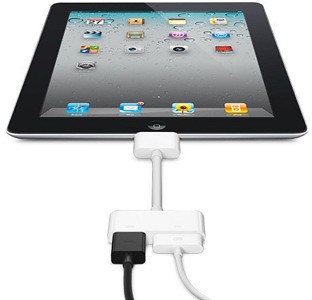 One of the new features of the iPad 2 is support for HDMI out in 1080p. To take advantage of the feature, iPad 2 users will have to fork over $39 for a Digital AV Adapter. Couldn’t have Apple saved users the trouble and implemented HDMI into the iPad 2 itself?
One of the new features of the iPad 2 is support for HDMI out in 1080p. To take advantage of the feature, iPad 2 users will have to fork over $39 for a Digital AV Adapter. Couldn’t have Apple saved users the trouble and implemented HDMI into the iPad 2 itself?
In short, yes, but monetary reasons in the form of HDMI licensing most likely played a factor in Apple’s decision.
Chris Alexander explains:
HDMI requires two licenses in order to be included in devices. The first is an annual fee and you have a choice: either $10,000 straight up (irrespective of number of devices sold), or $5,000 + $1 per device sold. Apple will undoubtedly have the first of these.
In addition to this, you must pay a royalty fee per device that you sell. This fee is a flat rate of 15 cents per device sold; it can be reduced to 5 cents per device if you include HDMI branding in your marketing and product packaging, and a further reduction to 4 cents if you implement the HDMI anti-piracy standard too…
If you sell 15 million units in 9 months, that equates to over $2,250,000 dollars – yes two and a quarter million – in royalty payments over a single connector. Alternatively, you could sell it as an add-on. Let’s assume 10% of iPad owners will also own the connector – that reduces the royalty payment to a paltry $225,000, which can easily be absorbed in the gigantic markup they make by charging $39 for 2 inches of cable.
While is this speculation, it makes a whole lot of sense. If people really want to take advantage of HDMI out, they’d certainly be willing to pay for an adapter. That being the case, Apple is not only saving money by not building HDMI into the iPad 2 but is making money overall on adapter sales.
As a point of interest, Apple’s Digital AV Adapter capable is compatible with the original iPad, the iPhone 4, and the 4th gen iPod Touch. But its 1080p mirroring only works with the iPad 2. Throughput on the other devices tops out at 720p.





March 8th, 2011 at 10:42 am
Expensive HDMI licensing makes a good case for positioning Thunderbolt as a standard for video-out on future devices. If Apple comes out with a Thunderbolt-enabled TV, that would begin the assult on the HDMI standard.
March 8th, 2011 at 12:27 pm
More significant than the minuscule HDMI licensing cost, each additional port increases weight, component count, manufacturing cost, and circuit board area. It adds another unsightly additional hole which weakens the case and potentially allows liquids to enter. All for what? So a small percentage of users, who need that functionality, don’t have to carry an external adaptor?
While HDMI is certainly handy for business and educational presentations, many home users will instead use AirPlay to wirelessly send video from their iPad to their Apple TV.
Apple is very smart about not piling on features just to satisfy the checklist geeks. They take a lot of flack because of that, but I admire Apple for its emphasis of elegance and simplicity.